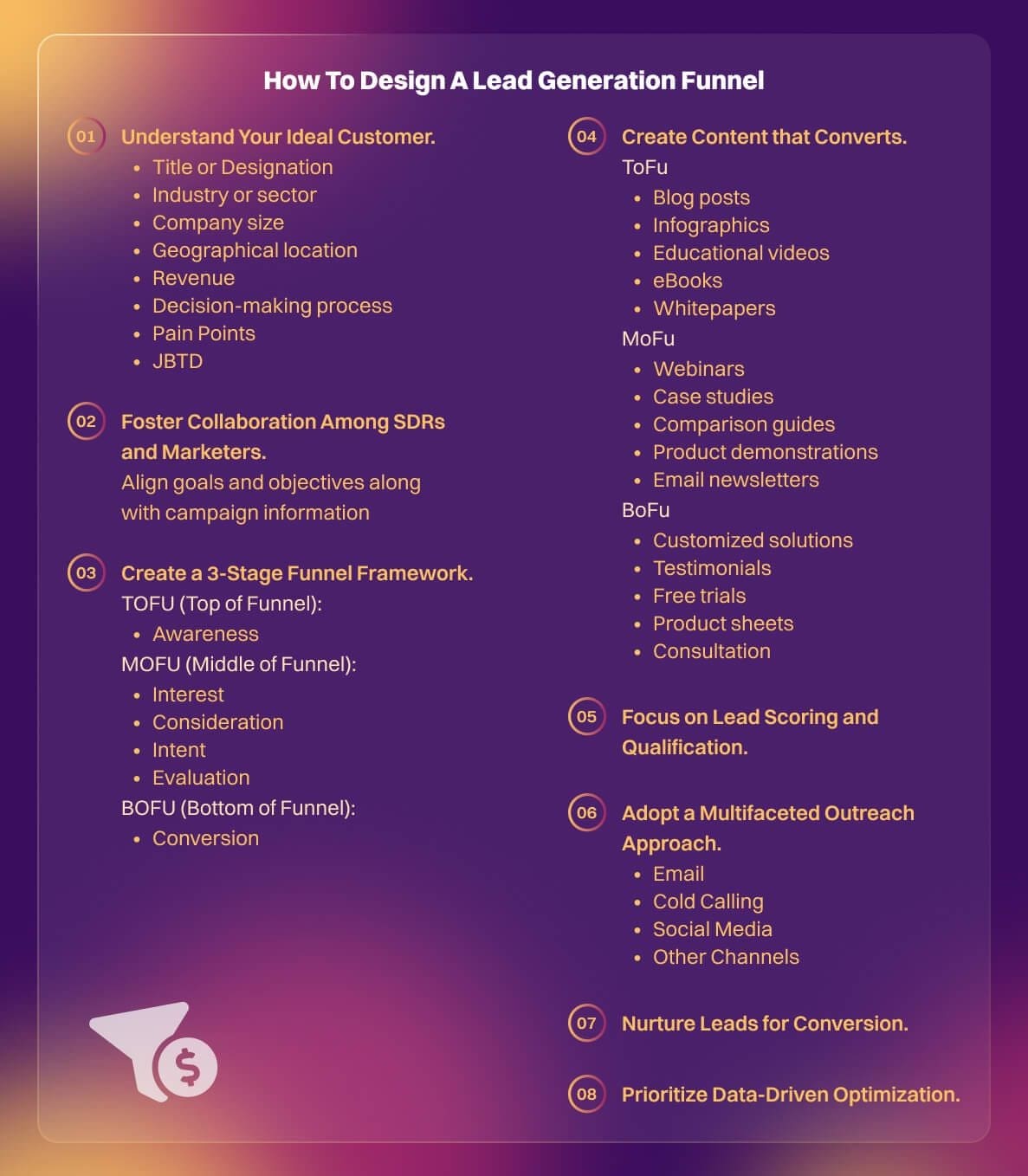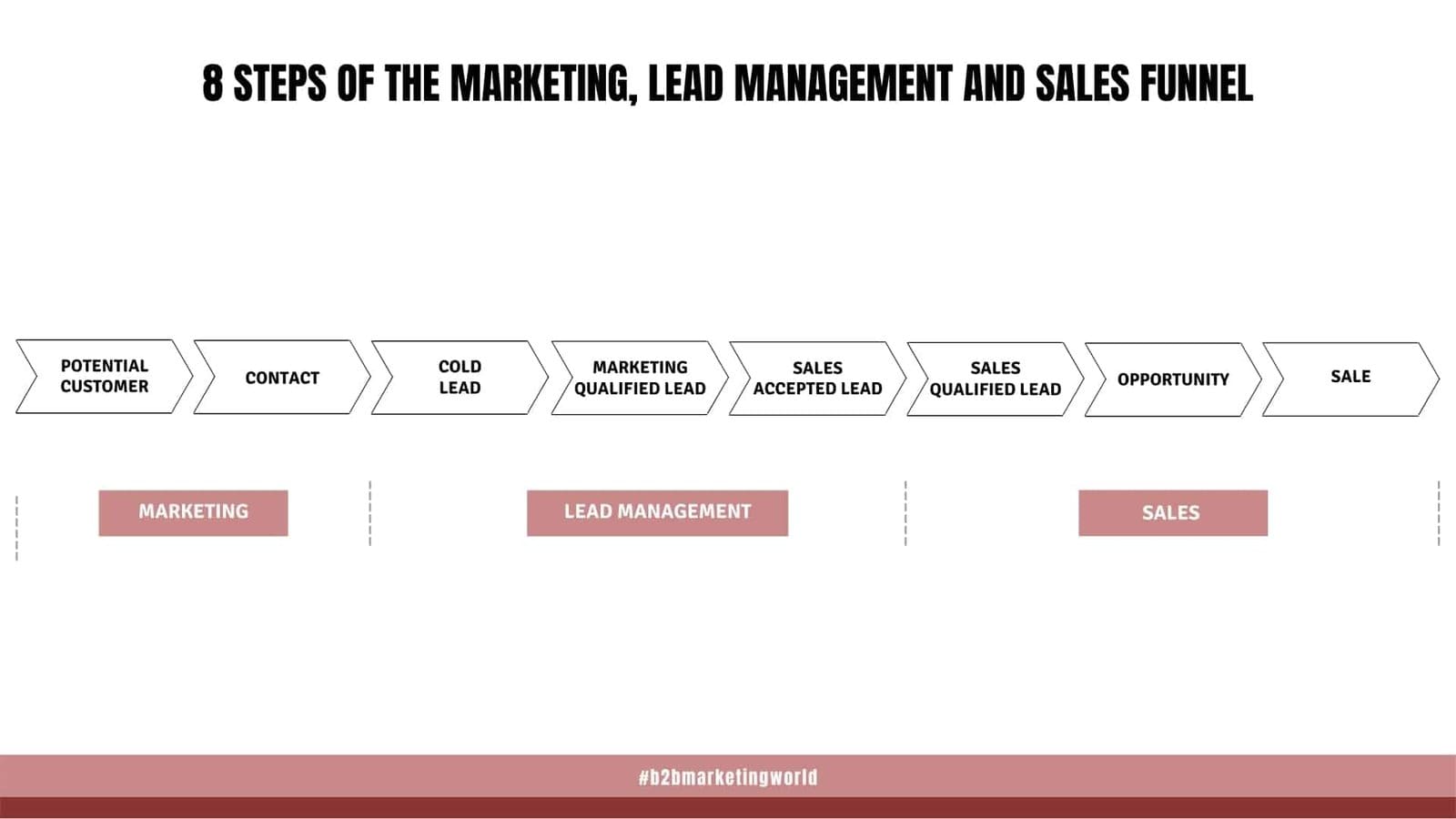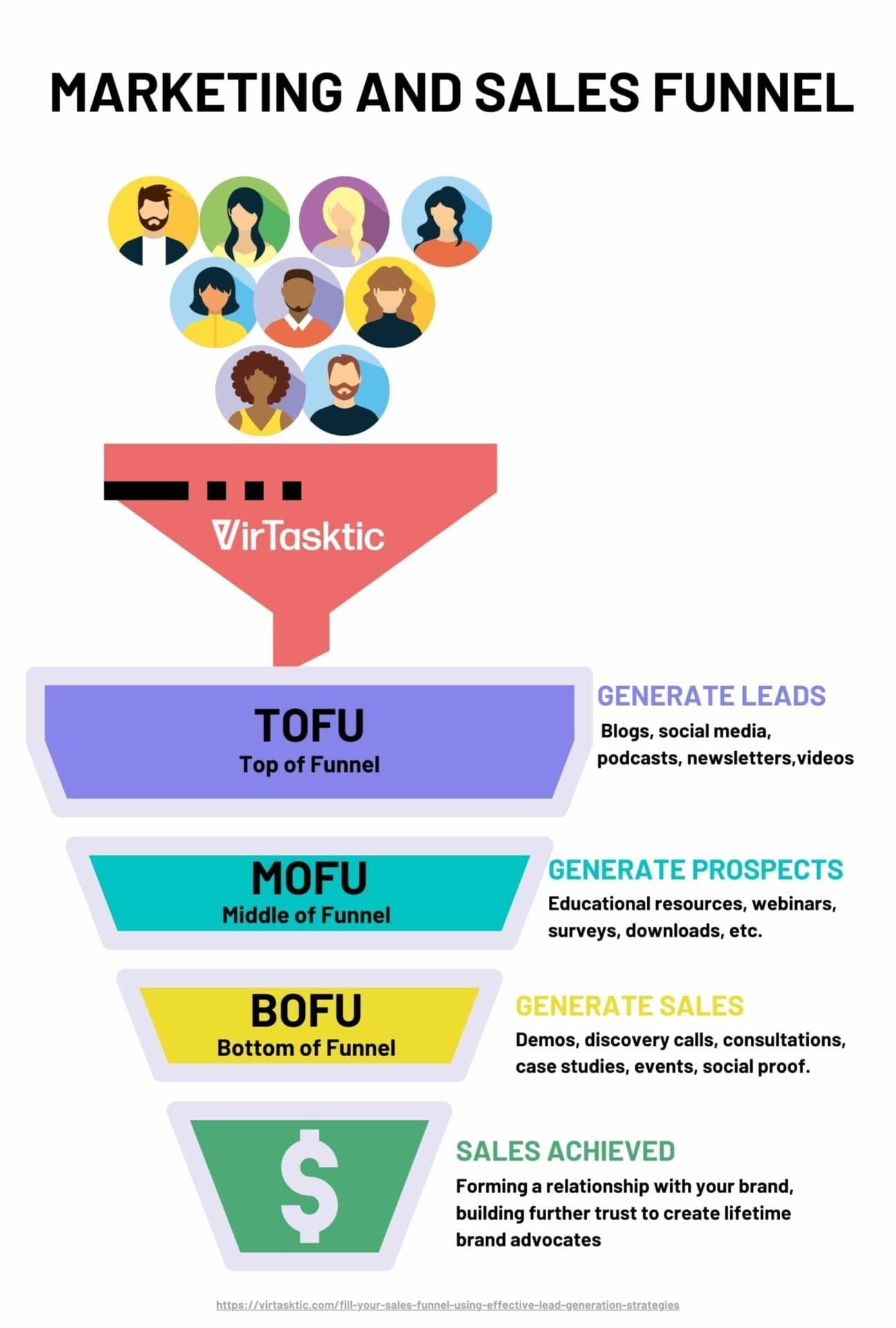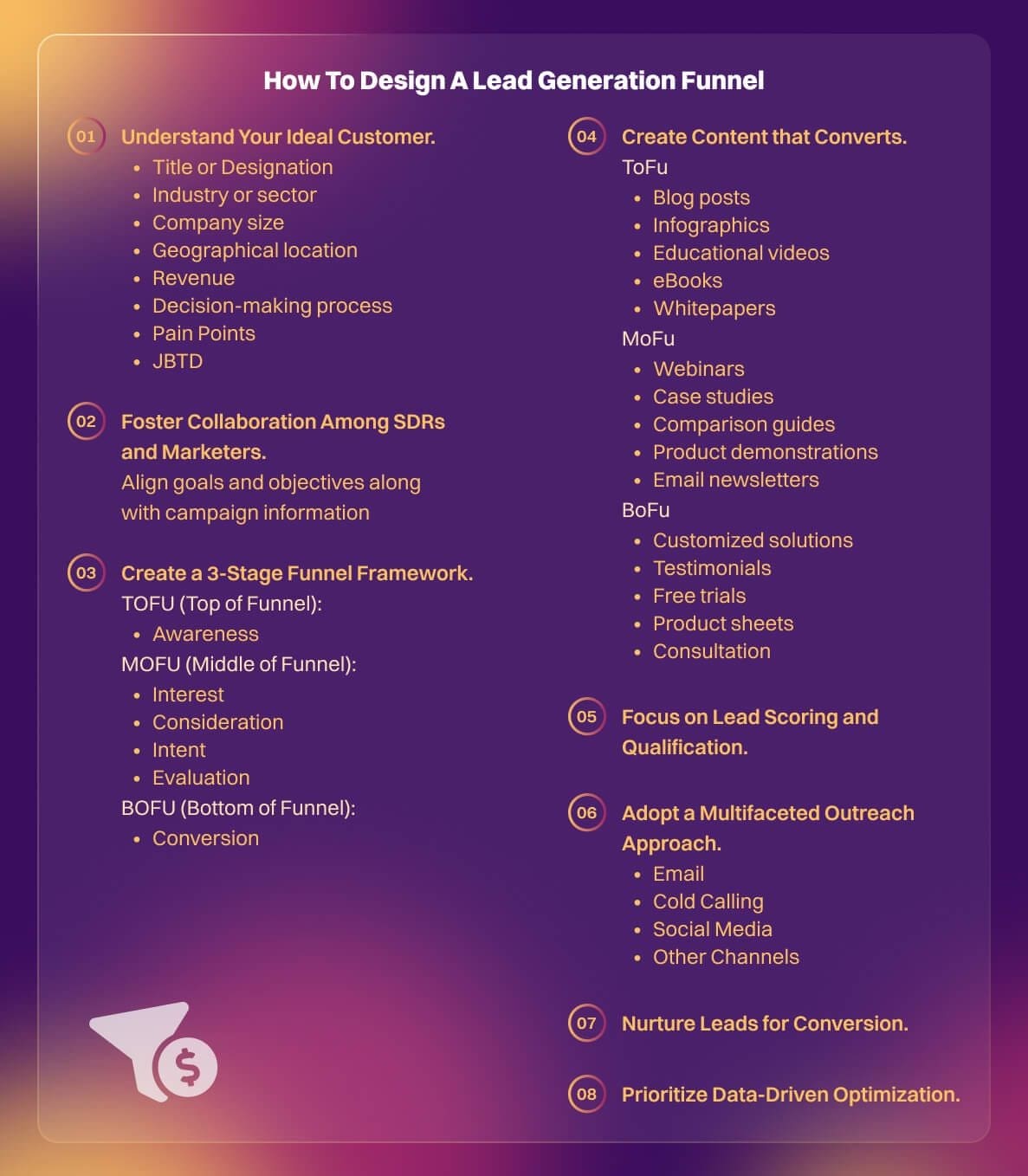We're here to share with you a foolproof guide on how to craft an effective lead generation funnel in just 8 simple steps. Generating leads is crucial for any business looking to grow and expand their customer base. In this article, we'll break down the process step by step, providing you with invaluable insights and techniques to maximize your lead generation efforts. From defining your target audience to optimizing your landing pages, we've got you covered. So let's get started and unlock the potential of your business with this comprehensive guide to creating a powerful lead generation funnel.
Step 1: Define Your Target Audience
Identify your ideal customer profile (ICP)
To create an effective lead generation funnel, it is crucial to clearly identify your ideal customer profile (ICP). This involves understanding the characteristics, needs, and pain points of the customers who are most likely to benefit from your products or services. By pinpointing your ICP, you can tailor your marketing efforts to attract and engage these specific individuals, increasing your chances of generating quality leads.
Research your target audience demographics
In addition to understanding your ICP, conducting thorough research on your target audience's demographics is essential. This includes gathering data on their age, gender, location, and other relevant information. By analyzing demographic trends, you can gain valuable insights into the preferences and behaviors of your target audience, enabling you to create more targeted and effective marketing campaigns.
Analyze your existing customer base
Another vital step in defining your target audience is to analyze your existing customer base. By examining the characteristics and behaviors of your current customers, you can identify patterns and trends that will help you better understand and connect with your target audience. This analysis can provide valuable information for crafting compelling offers and developing effective marketing strategies.
Create buyer personas
To better understand and connect with your target audience, it is essential to create buyer personas. A buyer persona is a fictional representation of your ideal customer, based on research and data. It includes details such as demographics, behaviors, goals, challenges, and motivations. By creating buyer personas, you can visualize and empathize with your target audience, which will guide your marketing efforts and help you create a more personalized and relevant experience for your potential leads.
Step 2: Develop a Compelling Offer
Understand your audience's pain points
To create a compelling offer, it is crucial to understand your audience's pain points. What challenges or problems are they facing that your product or service can solve? By identifying these pain points, you can position your offer as a valuable solution, increasing the likelihood of attracting and converting leads. Conducting market research, gathering customer feedback, and analyzing customer support inquiries can provide valuable insights into your audience's pain points.
Craft a valuable and relevant offer
Once you've identified your audience's pain points, it's time to craft a valuable and relevant offer. Your offer should clearly communicate the unique value proposition of your product or service and how it can address the specific needs of your target audience. It could be a free e-book, a webinar, a product demo, or a discount code. The key is to provide something of value that entices potential leads to take action and engage with your brand.
Use a powerful call-to-action (CTA)
To maximize the effectiveness of your offer, it's important to use a powerful call-to-action (CTA). A CTA is a clear and compelling directive that prompts your audience to take a specific action. Whether it's “Download Now,” “Register Today,” or “Get Your Free Trial,” your CTA should be concise, action-oriented, and persuasive. It should create a sense of urgency and clearly communicate the benefits of taking the desired action.
Employ lead magnets to capture interest
Lead magnets are valuable resources or incentives that you offer to potential leads in exchange for their contact information. This could be a free e-book, a checklist, a template, or any other resource that provides value to your target audience. By using lead magnets, you can capture the interest of potential leads and start building a relationship with them. Just make sure that the lead magnet is aligned with the pain points of your target audience and provides a taste of the value they can expect from your product or service.

This image is property of revnew.com.
Step 3: Design an Effective Landing Page
Keep the design clean and clutter-free
When designing your landing page, it's essential to keep the design clean and clutter-free. A cluttered and confusing design can distract visitors and make it difficult for them to understand and engage with your offer. Use white space, clear headings, and concise copy to create a visually appealing and user-friendly landing page. Make sure that the design elements align with your brand identity and create a cohesive and professional impression.
Optimize for mobile responsiveness
As more and more users access the internet through mobile devices, it's crucial to optimize your landing page for mobile responsiveness. Ensure that your landing page is fully mobile-friendly, with a responsive layout and design that adapts to different screen sizes. This will improve the user experience and prevent potential leads from abandoning your page due to a poor mobile experience.
Include persuasive copywriting
The copywriting on your landing page plays a significant role in capturing and holding the attention of potential leads. Use persuasive language that clearly communicates the benefits of your offer and addresses the pain points of your target audience. Highlight any unique selling points, testimonials, or social proof to build trust and credibility. Keep your copy concise, engaging, and easy to skim, using bullet points, headings, and bold text to emphasize key points.
Use captivating imagery and visuals
Visual elements such as images, videos, and graphics can greatly enhance the effectiveness of your landing page. Use high-quality and relevant visuals that align with your brand and support the messaging of your offer. Remember to optimize the file sizes of your images to ensure fast page loading times. Visuals can help grab attention, convey information quickly, and create an emotional connection with your potential leads.
Step 4: Create a Lead Capture Form
Keep the form simple and concise
When creating a lead capture form, simplicity is key. Keep the form fields to a minimum, asking for only essential information. The more fields you include, the higher the chances of potential leads abandoning the form before completing it. Only ask for information that is necessary for your lead nurturing efforts.
Include only essential fields
To increase the completion rate of your lead capture form, include only essential fields. Typically, this includes the name, email address, and perhaps one or two additional fields that are relevant to your business or offer. Asking for too much information upfront can deter potential leads from filling out the form.
Use clear and actionable language
The language used on your lead capture form should be clear, concise, and actionable. Use straightforward instructions and labels for each form field. Clearly communicate the value of filling out the form and reiterate any benefits or incentives that potential leads will receive.
Optimize the form for easy completion
Make sure your lead capture form is optimized for easy completion. Use user-friendly form fields, clear error messages, and intuitive design elements. Consider implementing autofill features or social media login options to streamline the process and reduce friction. Regularly test your form to ensure it is functioning properly and troubleshoot any issues that may arise.

This image is property of www.b2bmarketingworld.com.
Step 5: Implement Lead Nurturing Strategies
Segment your leads based on demographics and behavior
To effectively nurture your leads, it's important to segment them based on demographics and behavior. By dividing your leads into different groups, you can tailor your marketing messages and content to their specific needs and interests. Segmenting allows you to deliver more personalized and relevant experiences, increasing the chances of conversion and engagement.
Develop a personalized email marketing campaign
Email marketing is a powerful tool for lead nurturing. Design and implement a personalized email marketing campaign that delivers targeted content to each segment of your leads. Customize your emails based on their demographics, interests, and interactions with your brand. Use automation tools to streamline and optimize your email marketing efforts, ensuring that your messages are timely and relevant.
Offer valuable content through drip emails
Drip emails are a series of automated emails sent to leads over a specific period or triggered by specific actions or behaviors. Use drip emails to offer valuable content and resources to your leads, guiding them through the sales funnel and establishing your expertise and credibility. Provide informative blog posts, case studies, industry reports, or any other content that aligns with their needs and interests.
Engage leads with social media interactions
Social media is an excellent platform for engaging and nurturing leads. Regularly interact with your leads on social media by responding to their comments, sharing valuable content, and initiating conversations. Use social media listening tools to monitor mentions and discussions related to your brand or industry. Engaging with your leads on social media can foster trust, build relationships, and keep your brand top of mind.
Step 6: Qualify and Score Your Leads
Establish lead scoring criteria
Lead scoring is a process of assigning a numerical value, or score, to your leads based on their interactions, behaviors, and demographics. Establish lead scoring criteria to prioritize and qualify your leads. Assign higher scores to leads who have demonstrated a higher level of engagement and interest, such as opening emails, visiting specific web pages, or downloading resources. Lead scoring allows you to focus on leads with the highest potential, ensuring that your resources are utilized effectively.
Track lead activities and engagement
To effectively qualify and score your leads, it's crucial to track their activities and engagement. Use marketing automation tools or customer relationship management (CRM) software to monitor and record each lead's interactions with your brand. This includes email opens, clicks, website visits, content downloads, social media engagements, and any other relevant actions. Tracking these activities will provide valuable insights into each lead's level of interest and readiness to convert.
Use lead scoring to prioritize follow-ups
Once you have assigned scores to your leads, use lead scoring to prioritize your follow-ups. Focus on leads with higher scores who have shown more interest and engagement. These leads are more likely to be receptive to your messaging and have a higher potential for conversion. Devote your time and resources to nurturing and converting these prioritized leads before moving on to leads with lower scores.
Evaluate and refine your lead qualification system
Regularly evaluate and refine your lead qualification system to ensure its effectiveness. Analyze the performance of your lead scoring criteria and adjust them as needed. Keep track of the conversion rates and sales generated from qualified leads to measure the success of your lead qualification system. Continuously fine-tune and optimize your processes to maximize the efficiency and impact of your lead generation funnel.

This image is property of b1016611.smushcdn.com.
Step 7: Drive Traffic to Your Funnel
Optimize your website for search engines (SEO)
To drive traffic to your lead generation funnel, it's crucial to optimize your website for search engines. Perform keyword research to identify the terms and phrases that your target audience is searching for. Incorporate these keywords into your website content, meta tags, and headings to improve your search engine rankings. Create high-quality and informative content that addresses the needs and interests of your target audience, increasing your chances of appearing in relevant search results.
Leverage paid advertising campaigns
Paid advertising campaigns can be an effective way to drive targeted traffic to your lead generation funnel. Consider using platforms such as Google Ads or social media advertising to reach your target audience. Set clear goals and objectives for your campaigns, and carefully track and measure their performance. Optimize your ads based on the insights gathered from your analytics, ensuring that they are generating qualified leads and delivering a positive return on investment.
Utilize social media marketing strategies
Social media is a powerful tool for driving traffic to your lead generation funnel. Identify the social media platforms that your target audience is most active on and develop a social media marketing strategy to engage with them. Share valuable content, run targeted ads, and actively participate in relevant industry conversations. Use social media analytics to measure the success of your efforts and make any necessary adjustments to optimize your results.
Guest blog on relevant industry websites
Guest blogging on relevant industry websites is a great way to reach a wider audience and drive traffic to your lead generation funnel. Identify reputable websites in your industry that accept guest blog posts and pitch them with high-quality, informative, and engaging content ideas. By providing value to their readers, you can establish your expertise, increase brand visibility, and attract potential leads to your funnel. Include a compelling call-to-action within your guest blog posts to encourage readers to visit your landing page and engage with your offer.
Step 8: Continuously Optimize Your Funnel
Analyze funnel performance metrics
To ensure the effectiveness of your lead generation funnel, it's important to continuously analyze its performance metrics. Track key metrics such as conversion rate, bounce rate, time on page, click-through rate, and lead-to-customer conversion rate. Identify any areas of improvement or bottlenecks that may be hindering your funnel's performance. Keep a close eye on the data and identify trends over time to make informed decisions about optimizing your funnel.
Identify areas for improvement
Based on the analysis of your funnel's performance metrics, identify areas for improvement. This could involve making changes to your landing page design, lead capture form, email marketing content, or any other element within your funnel. Look for opportunities to enhance the user experience, increase engagement, and remove any roadblocks that may be preventing leads from progressing through the funnel. A/B testing different variations of elements within your funnel can help you identify the most effective strategies and optimize your results.
A/B test different elements of your funnel
A/B testing involves testing two or more variations of a specific element within your funnel to determine which performs better. This could include testing different headlines, CTA buttons, landing page layouts, or email subject lines. By running controlled experiments and analyzing the results, you can make data-driven decisions about which variations yield the highest conversion rates and engagement. Continuously testing and optimizing your funnel will help you improve its effectiveness and maximize your lead generation efforts.
Regularly update and optimize your strategy
To stay ahead of the competition and maintain an effective lead generation funnel, it's crucial to regularly update and optimize your strategy. Monitor industry trends, changes in consumer behavior, and advancements in technology that can impact your funnel. Stay informed of the latest best practices and techniques in lead generation and implement them into your strategy. Continuously adapt and refine your approach to ensure that you are delivering the best possible experience to your potential leads and maximizing your chances of success.

This image is property of i0.wp.com.
Conclusion
Creating an effective lead generation funnel involves several crucial steps, from defining your target audience and developing a compelling offer to implementing lead nurturing strategies and continuously optimizing your funnel. By following these eight steps and adopting a data-driven approach, you can attract, engage, and convert quality leads, fueling the growth of your business. Be sure to monitor and analyze the performance of your funnel regularly, making necessary adjustments to optimize results and stay ahead of the competition.








